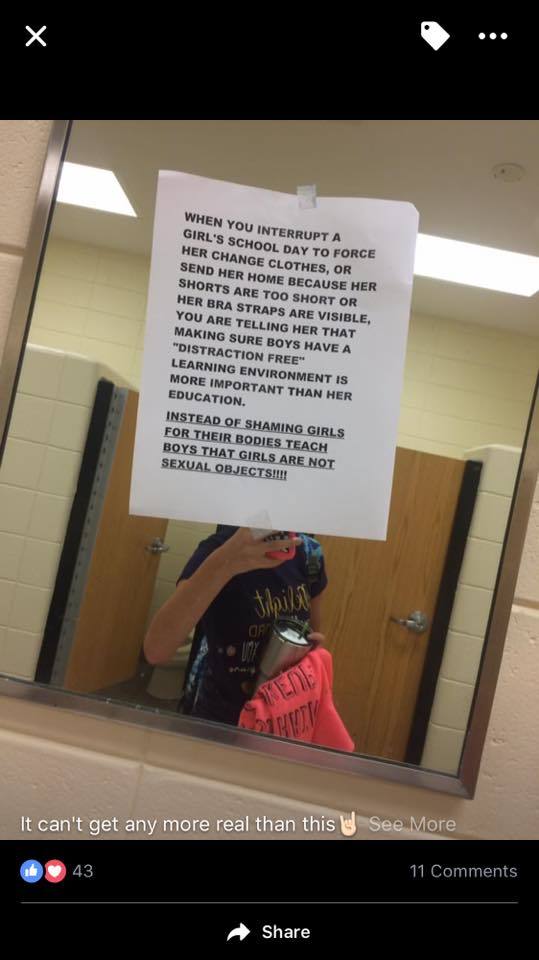
Overheard last week in my car as I shuttled around my 15-year-old daughter (DD) and 17-year-old son (DS) for some last-minute vacation shopping:
DS: Jake and some other friends said I need new shirts. They’re not fashionable.
This is the first time I had ever heard my son utter the word “fashionable.” Since babyhood, I could literally buy him anything and, as long as I didn’t drag him shopping, and it didn’t make him itch, he’d be good with it.
DD to DS: Well, maybe that one Hawaiian shirt you wore last week…
Me (explaining, to no one in particular): I got that for a Hawaiian luau. For that one purpose―
DD to DS: Fashionable for boys is about brands. It’s easier for you than for girls.
Me: <sigh>
That’s for damn sure.
How we humans clothe ourselves has historically been a cultural landmine, particularly when it comes to gender. It begins almost from birth, when baby leaves the hospital with either a pink or blue blanket. While societal norms shift over time and across geography, males and females have been expected to fall neatly into one or the other gender, and dress accordingly.
When I was very young, a girl who wore pants and short hair might be seen as a “tomboy.” When I was a teen, a boy who took special care of his hair and wore pink might be seen as “gay” and a girl who dressed in a way that revealed too much skin (in someone else’s opinion) might be seen as a “slut.” In all of these cases, such labels were certainly not considered to be complimentary, and a stigma often attached.
At least in some parts of the country (read: Trump country), views have not changed that much. In my part of the country — a blue county in a blue state — tolerance for individuality when it comes to dress and gender has come a long way, and gives me hope for the future. Nevertheless, as Americans, we still have a long, long way to go.
Now: If a young girl dresses in so-called boys clothing or looks “boyish,” we might leap to the assumption that she is “transgender,” and maybe she/he is. But maybe we should just let her be a human being, and not feel the need to lock her in to one of two genders when she’s only six years old.
Now: If a girl wears a “revealing” costume and heavy makeup on stage for a dance or other competition, we might take her mother to task for inappropriately “sexualizing” her daughter. But maybe it is really the adult onlookers who are inappropriately sexualizing an innocent, young girl.
Now: Many high schools, even in progressive counties throughout the United States, have dress codes that are more restrictive of girls than of boys. A girl who violates a dress code may be sent home from school to change her clothes. These sexist dress codes presume that it is more important for a high school boy not to be distracted by a girl’s bare shoulders or thighs, than for the girl to be allowed to dress as she chooses. For the girl, it is demeaning to be called out in class for how she is dressed and disruptive to her education to be sent home and miss school. But maybe we should consider the girl’s needs and feelings, and put responsibility on others not to sexualize and stigmatize her choice of how to express her individuality.

Posted in a high school bathroom, a girl expresses her frustration with the school’s sexist dress code.
Now: We continue to ask what the victim of a rape was wearing when she was assaulted, as if the answer might somehow exculpate the rapist. “She was asking for it” is a typical reaction from some if they hear the rape victim was wearing something they consider to be “sexy.” In this worldview, choice of clothing apparently equals consent for sexual assault. Maybe though, we should simply hold rapists accountable for their violent and criminal acts. Do we let off a murderer if he grabs a gun out of his victim’s hand and shoots her with it? Do we let off a burglar if he walks through an unlocked door and steals a priceless work of art off of the wall?
There is power in expressing one’s individuality. It is empowering to a girl or woman to be permitted to choose how to dress, regardless of how unconventional it may seem to society. Just ask some of our most famous cultural icons, from Marilyn and Madonna to Lady Gaga and Miley Cyrus. Ariana Grande has defiantly informed her legions of fans on Twitter that a woman’s choice of clothing is part of her freedom of choice as a woman, and an expression of her own unique personality:
On the other hand, rules restricting freedom of dress can have the opposite impact, with negative consequences. Cultural and symbolic examples of this can be found everywhere, including two fictional protagonists, who are currently featured in motion pictures.
At one end of the extreme is the puritanical dystopian world depicted in “The Handmaid’s Tale.” Women in this Margaret Atwood novel/Hulu series have been stripped of all power and control over their lives and the handmaids’ sole function in life is to bear children. To symbolize their total subservience to men, the story’s protagonist, Offred, and the other handmaids must wear red and are required to be covered from head to toe at all times. Extreme or fundamentalist religiosity in one form or another is similar in that complete modesty in dress is a requirement for women, and sexuality exists only for procreation. Given conservative political trends, such as the assault on women’s rights to choose for themselves when they bear children, women who have recently protested state measures infringing on abortion rights have taken to wearing handmaids’ costumes. The symbolic meaning is clear: When powerful men strip women of some of their rights, where does it end?
Then, at the other end of the extreme, we find Princess Diana, also known as Wonder Woman. Diana is born on a utopian island, where women reign supreme (and indeed there are no men to interfere with or control them). They wear revealing clothing—a strapless bodysuit—all the time, including during battle. Wonder Woman is a mythical superhero with superhuman powers. She is virtually invincible and indestructible. She also doesn’t rely on men to achieve success in life and, indeed, the character was originally inspired by some of the earliest American feminists, such as Margaret Sanger. In the movie, to further highlight the dichotomy between the women of Themyscira and the real world, a blissfully naïve Diana takes her feminist sensibilities with her to World War I-era Great Britain. She negotiates the outfit she must wear to walk the streets of London (finally deciding on an unusual but still more conventional look, with black hat, modestly long skirt, and belted jacket), but as soon as she starts her heroic assault on the German forces as Wonder Woman, she’s back in her badass bustier. Symbolically, part of her power is in her ability to break free of society’s attempts to keep her in check and under wraps, so to speak.
Returning to “real life,” a beach resort town recently fought back against a woman who had asserted her right to go topless on the “family” beaches of Ocean City, Maryland. Surely this woman had a point. Why is it legal for a man to go sunbathing topless and not a woman? The traditionalist answer—to protect families from seeing bare breasts—is mired firmly in our own puritanical sensibilities, whether we realize this or not. The sexualization of female but not male nipples (many bikinis reveal plenty of flesh but the nipples always remain under cover) is a cultural and societal construct and modesty laws blindly follow this construct. Indeed, many if not all of the children on the beach have likely been breastfed by their mother. How does this law protect them? So what if they see a bare-breasted woman on a beach? We effectively send the message to these children that female body parts are taboo and shameful sexual objects, a belief that will continue to be perpetuated.
Symbolism when it comes to women and clothing pervades real world business and politics as well. Men can simply wear a nice suit and tie with a crisp white shirt, and call it a day. No one notices or cares (or asks about the designer). By contrast, Hillary Clinton made an enormous splash back in the ’90s when she famously (infamously?) began eschewing traditional dresses or skirt suits for pantsuits. She continues to be known for her multitude of pantsuits, and last November, many women and their daughters showed up to the polls in a symbolic pantsuit as they cast their vote for a woman to hold the most powerful office in the free world.
Ironically, when I was a young attorney at a large, conservative law firm back in the 1990s, hardly any women dared to wear pants to work, but wearing short skirts was considered perfectly fine. Compare that with today’s high school girls, who are expected to cover themselves up during school hours, apparently to avoid distracting boys. And if there’s any doubt to how extreme these modesty rules can be, just take the recent case of a North Carolina high school senior with a 4.4 GPA, who was suspended for a dress code violation and missed her own graduation.
Dress or decorum codes have also been imposed in the U.S. House of Representatives by the Speaker of the House, Paul Ryan. Specifically, female journalists are not permitted to go sleeveless.
The double bind with which we women have always had to navigate continues on—be “feminine,” but “sexy,” but not too sexy, and dress accordingly. But wouldn’t it be Wonder-ful if we could all express our individuality through clothing and not be endlessly judged in an attempt to suppress our superpowers?
This article has been updated to include the decorum rule in the House of Representatives that has been used to exclude women reporters wearing sleeveless tops or dresses.
